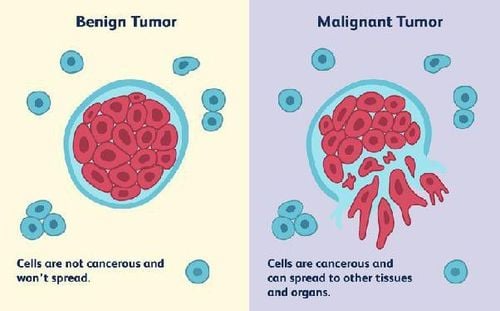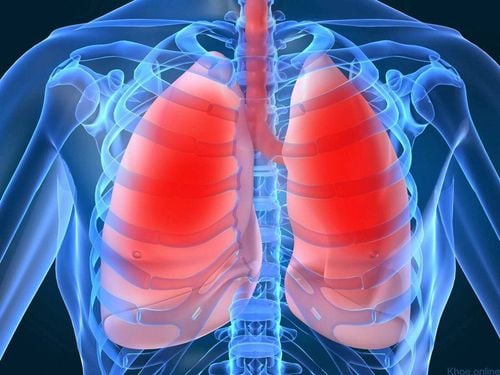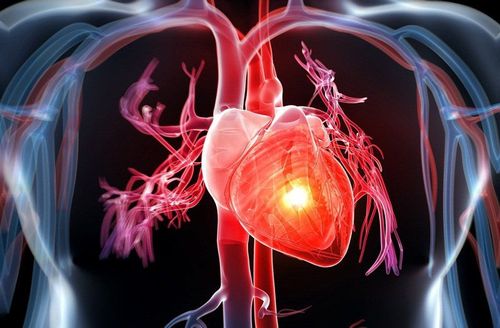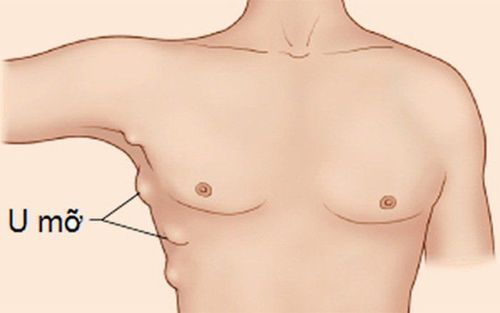This is an automatically translated article.
Benign tumors do not invade nearby tissues or spread to other parts of the body like malignant cancer cells. Whether or not treatment for a benign tumor is necessary will depend on the nature and location of the tumor.
1. Benign Tumor Overview
In general, tumors are the result of abnormal and dysfunctional cell growth. There are two different types of tumors: benign and malignant (also known as cancerous). For the most part, the outlook for benign tumors is usually very good. But if a benign tumor compresses important structures, such as blood vessels or nerves, it can be quite a problem.
Benign tumor formation is often unexplained. However, the development of a benign tumor can be related to a number of factors, such as:
Environmental toxins, such as radiation exposure; Genetic factors; Diet; Stress, tension; Injury; Inflammation or infection.

2. Benign tumor treatment
In most cases, treatment for benign tumors is not necessary. Instead, doctors just need to actively monitor them to make sure the tumors aren't causing any problems.
However, the treatment of benign tumors may be applied when it is necessary to control the symptoms affecting health caused by the tumor. One of the most common forms of benign tumor treatment is surgery. This method will help remove the tumor without damaging the surrounding tissue. In addition, other treatment options may also include medication or radiation therapy.
Trắc nghiệm: Thử hiểu biết của bạn về bệnh ung thư
Ung thư là nguyên nhân gây tử vong hàng thứ 2 trên thế giới. Thử sức cùng bài trắc nghiệm sau đây sẽ giúp bạn có thêm kiến thức về yếu tố nguy cơ cũng như cách phòng ngừa bệnh ung thư.
Bài dịch từ: webmd.com
3. Common types of benign tumors
There are different types of benign tumors that arise from many structures in the body, some of the most common of which include:
3.1. Adenomas are benign tumors that form in the epithelial cells of glandular structures. The thin epithelium covers both organs and structures of the body and is a collection of cells that make up the endocrine and exocrine glands. Types of adenomas most often develop in:
Polyps in the colon; Liver; Adrenals; Pituitary; Thyroid. If necessary, the adenoma can be removed surgically. Although rare, sometimes this type of tumor also carries the risk of becoming malignant. In the colon, for example, the rate of benign adenomas turning into cancer is close to 1 in 10.
3.2. Fibroids or Fibroids Fibroids are tumors of fibrous or connective tissue and can develop in any organ, but are most commonly found in the uterus. Although not cancerous, fibroids can lead to heavy vaginal bleeding and bladder problems or pelvic pain.
Another type of fibrous tumor that affects nearby tissues is called sclerosis. Fibrocystic fibroids need to be surgically removed to control symptoms that impact health.
3.3. Hemangioma or hemangioma This type of benign tumor is an accumulation of blood vessel cells in the skin or internal organs. Hemangiomas usually take the form of a bluish birthmark or red lump, appearing mainly on the head, neck, or trunk (excluding arms and legs). Most hemangiomas will go away on their own with time, but if they affect a patient's vision, hearing, or ability to eat, they may require treatment with corticosteroids or other medications.
3.4. Lipomas Lipomas, which develop from fat cells, are the most common benign tumor in adults and are usually found on the neck, shoulders, back, or arms. Fat tumors are slow-growing, often round, tender, and movable to the touch. Lipomas appearing on the human body can be inherited in families or due to effects after trauma. If a lipoma is painful or grows rapidly, it may need to be treated with steroid injections, liposuction, or surgery to remove it.
There are also two other types of benign lipomas: lipomas (which often occur in young children) and tumours (brown lipomas).
3.5. Meningiomas As the name suggests, these are tumors that develop from the membranes surrounding the brain and spinal cord. About 9 out of 10 cases of meningiomas are benign, most of which grow slowly, but there are some exceptions. Treatment for benign meningiomas will depend on where they appear and the symptoms they cause, such as: headaches, unilateral muscle weakness, seizures, mood swings, and vision problems. sense.
Usually, the doctor will choose to monitor the tumor for a while in advance. Then, if surgery is needed, the success of the treatment for benign meningiomas will be determined by the following factors:
Age of the patient; The site of tumor formation; Adjacent structures attached to the tumor (if present). In cases where the tumor cannot be removed, radiation therapy may be used.
3.6. A leiomyoma is a tumor that develops from muscle or smooth muscle within the walls of blood vessels and is found in internal organs such as the stomach and uterus (similar to uterine fibroids). There is also a rare benign tumor of skeletal muscle called rhabdomyosarcoma. Usually, these tumors require mere observation. However, if there are symptoms that require treatment, the doctor will shrink them with medication or remove them surgically.
3.7. Melanoma (mole) Melanoma grows on the skin as pink, brown, or black moles. A person can form and develop new melanomas until about age 40. If you have a mole with an irregular shape, it can be a warning sign that the tumor has turned malignant, causing the risk of skin cancer. Therefore, it is very important to check the skin regularly, especially when there are moles with unusual signs as follows:
Change in shape over time; Has an irregular border; Change color. To check if a melanoma is a warning sign of cancer, doctors sometimes need to perform a procedure to remove a suspected mole.

3.8. Neuroma The three types of tumors that develop from the nerves include:
Neuroma; Neurofibromatosis; Nerve capsule. These benign nerve tumors can appear all over the body where nerves run. There is also neurofibromatosis - a genetic disorder that disrupts cell growth in the nervous system. Surgery is the most common form of treatment for benign nerve tumors.
3.9. Osteochondroma is the most common benign bone tumor, usually appearing as one or more painless lumps near joints, such as the knee or shoulder. Your doctor will diagnose this benign tumor through an X-ray imaging test. If the tumor causes pain or puts pressure on nerves and blood vessels, surgical treatment of the benign tumor may be necessary.
3.10. Papilloma (Wart) A papilloma is a tumor that develops from epithelial cells that cover the stratum corneum or mucosa, which can be either benign or malignant. Papillomas most often appear on the skin, cervix, mammary glands, or conjunctiva (the mucous membrane that covers the inside of the eyelids). These tumors are the result of direct exposure to the human papillomavirus (HPV). Some types of benign papillomas will go away on their own, but surgery is needed to rule out malignant papillomas that are causing cancer.
To detect and control benign tumors, prevent progression to cancer, Vinmec International General Hospital provides customers with cancer screening packages according to age, sex and pathology such as: Lung cancer screening, stomach cancer screening, breast cancer screening,...For the purpose of health control, timely detection and treatment of disease.
Customers can directly go to Vinmec Health system nationwide to visit or contact the hotline here for support.
References: Webmd.com
MORE:
How are malignant tumors different from benign tumors? Differential diagnosis of malignant tumor - benign tumor by immunohistochemistry Is the diagnosis of benign tumor worrisome?













